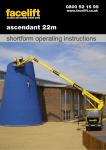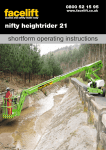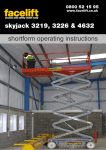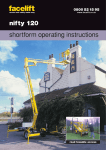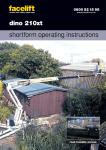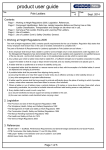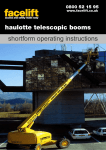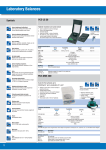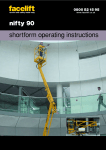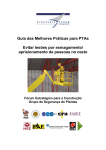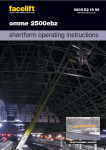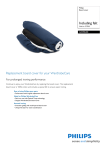Download shortform operating instructions
Transcript
B 0800 52 15 95 www.facelift.co.uk ascendant 17m shortform operating instructions SAFETY TIPS ALWAYS NEVER • Inspect your machine before use. • Use an unsafe machine. • Check all operations including ground controls. • Use an access platform to hoist loads like a crane. • Check ground conditions. • Overload cage/platform. • Check clearance from overhead obstructions (power cables, building projections etc). • Operate in strong winds (Check manufacturer’s recommendation). • Plan your task/job. • Rest the cage on a structure or object to gain extra support. • Use sole boards under your outriggers at all times regardless of ground conditions. • Stabilise and level machine before use. • Wear a safety harness connected to a suitable anchorage point inside the platform. • Operate all controls smoothly. • Warn other people that you are there by means of flashing lights, sign and cones. • MAKE SAFETY YOUR No.1 PRIORITY. • Attach your safety harness to a structure outside of the platform. • Throw or drop anything from the platform. • Use boxes, ladders or stand on handrails to gain additional height, if you can’t reach, you need a bigger machine. • Let an untrained person operate the access platform. • Take unnecessary risks (hospitals and graveyards are full of dead heroes!) In the unlikely event that your machine develops a fault please contact the Facelift Tech Team on 01444 881100 CONTENTS General Safety.......................................................3 Cage Controls........................................................11 Operator Guide......................................................5 Emergency Controls..............................................12 Ground Controls....................................................9 Troubleshooting.....................................................13 2 GENERAL SAFETY NOISE During normal operation the maximum sound level will not exceed 85 Dba. THE OPERATOR • Must be medically fit and have good eyesight and hearing. Any medical condition that may effect the safe use of this access platform must be reported e.g. epilepsy heart disease etc. • Must have a good head for heights. • Must have been trained in the safe use of access platforms, hold a current certificate and be fully conversant with the content of this manual. • Must be very aware of the safety requirements concerning the persons working with them and the persons in the general vicinity of the access platform. • Must not use this piece of equipment for any purpose other than that for which it was intended • Must carry out the necessary pre-start checks as described in the operating section of this manual and must not operate the platform should it not be in first class condition. 3 WARNINGS DO NOT operate this platform: • On surfaces that are sloping, not hard standing or slippery without adequately supporting the platform. The 17-12 has been designed to work on surfaces with a minimum bearing strength of 50N/cm^2 • With items likely to increase the wind loading on the platform above acceptable levels e.g. notice boards etc. • With any equipment in the cage likely to increase the working height or outreach e.g. ladders. • For any special purpose that may produce special loads or forces. Any such application must be discussed with the manufacturer and their approval given. • Near or close to live electrical conductors. The minimum safe distance for the 17-12 is 26.7m measured from the centre of rotation of the platform to the power lines. It is the operator’s responsibility to ensure this safe distance is maintained. • Should it be necessary to work closer to the power lines then the operator must ensure that the power has been switched off before attempting to work, a written permit to work must be obtained from owners of the power cables or the responsible Persons. • Unless there is a current certificate of safe use of the platform issued by a competent person. • Into the path of oncoming traffic when working on a public highway. 4 OPERATOR GUIDE 2 PRE-START CHECKS The following pre-start checks must be carried out before operating the platform. • Hydraulic fluid The oil level in the tank must be full when the platform is in the transport position. • Cut out switches All cut-out and safety switches must be working correctly. • Emergency stops Check that the emergency stops are operating correctly and that they are all in the run condition. • Damaged/loose fittings Inspect the machine to ensure there are no signs of damage or loose hoses and fittings. • Vehicle Check that there is enough fuel in the vehicle for a full shifts work. 5 1. SETTING UP Do not attempt to set up the machine on steep slopes, ramps or soft ground. • Park the vehicle in an appropriate location, remove from gear, apply the handbrake and engage the PTO. • Ensure that the working area of the platform is coned off. • Ensure that the platform is switched on (located on the vehicle dashboard). • Leave the vehicle cab and go to the ground control station. CONTROL STATIONS 6 GROUND CONTROL BOX OUTRIGGER BEAMS CONTROL 7 OUTRIGGER JACKS CONTROL • • • Deploy the outrigger beams (Note; the outrigger jacks must be in the stowed position before carrying out this operation.) (Note; the passenger door must be closed before carrying out this operation.) • Operate the outrigger jack controls until all four feet are just touching the ground, then, simultaneously operate the front (cab end) jacks and then the rear until all jacks are in firm contact with the supporting surface, the chassis is level (according to the level gauge) and the wheels are approximately 5-10cm off the ground. (Four green “Outriggers under load” lights should show on the outrigger control box). A green “Platform controls” should also be lit. • Check that the feet are in firm contact with the ground • Remember the maximum load that will be imposed by the platform foot and be sure the surface you have set it up on can support it. 8 GROUND CONTROLS • Telescope out the boom until it is possible to gain entry to the cage. • The platform may now be operated from either the turret or the cage. 9 OPERATING THE PLATFORM. ASCENDANT ACCESS LTD recommends the use of a safety harness. Harness anchor points are located in the cage. This product features limited slewing ie it is possible to slew approx. 20 deg to the off-side and up to the rear of the cab on the near-side. • Select either ground or cage with the key switch situated on the ground control box. 10 MAIN BOOM SLEWING TELE BOOM CAGE ROTATE CAGE TRIM CAGE CONTROLS The booms can now be operated freely by using the appropriate control lever. WARNING Before raising. Ensure that there are no overhead obstructions. Should the cage be overloaded a warning light will show and the platform controls will be disabled the platform cannot not be operated until the excess payload is removed. • Vehicle engine remote stop and start is provided at all operating stations. • The extending structure will also automatically stop if an outrigger jack becomes light and begins to leave the supporting surface. An override button is also provided should this condition occur and the platform must be returned to the transport position and the outriggers reset. • Should the cage become out of level whilst operating it may be reset by operating the cage trim lever. 11 2. EMERGENCY CONTROLS • Red emergency stop buttons are located on the platform in the cage and at the base to stop the platform in an emergency. • An emergency hand pump is provided (mounted on the side of the ground control station) should all power fail. Simultaneous operation of this along with actuating the appropriate lever in the cage will bring the platform down. 3. STOWING. • Telescope the boom fully in and line it up with the docking pocket. Lower the main fully boom. Telescope out until it is possible to leave the cage. Ensure the cage rotate is in its central position. Leave the cage. Return the telescope to the transport position. • Fully raise the outrigger jacks. (note this will not be possible if the booms are not stowed). WARNING do not attempt to retract the outrigger beams until the jacks are fully raised • Fully retract the outrigger beams. The green “outrigger stowed” should show on the outrigger control box. • Check that the “booms not stowed” and “outriggers not stowed” lights are out on the vehicle dash. • Disengage the PTO • Switch off the platform. • The vehicle is ready to drive away. 12 TROUBLE SHOOTING It is recommended that faultfinding be only carried out by technically competent personnel. Whilst every effort has been made to ensure that these procedures are comprehensive they will not cover every eventuality • Vehicle engine wont start • • • Outrigger beams will not operate • • • • • Check platform is switched on (located in vehicle cab). Check PTO is engaged. Check that booms are correctly stowed and that the limit switch has not malfunctioned (located behind cover on boom prop). Check hydraulic oil level. Outrigger jacks will not operate • • • Check all emergency stops are in the platform run condition. Refer to vehicle manufacturer trouble shooting guide. Check boom docking. Check oil level in hydraulic tank. Booms will not operate • • • • • Check correct operating station has been selected. (switch located at turret control box). “Platform controls” light on turret and cage control boxes should be lit. Check that outriggers are correctly deployed (i.e. in firm contact with the ground and all indicator lights are correctly lit, (see operating guide)). Check light leg indicator is not lit. Check outrigger limit switches are operating correctly. 13 facelift 0800 072 55 72 www.facelift.co.uk access and safety made easy operator training centre When hiring access equipment we strongly recommend taking advantage of one of our operator training courses. As Facelift is an accreditied IPAF (Independent Powered Access Federation) training centre you can be sure that your staff will be trained to a high standard and receive an internationally recognised qualification. Courses can take place on your own premises or at one of our training centres, situated in Hickstead, Iver, Southampton, Liverpool, Birmingham and Basildon. We can train your personnel on any of the following equipment: (1a) Static Vertical Vertical Personnel Platform (static) (1b) Static Boom Self Propelled Boom with outriggers, Trailer/Push around, Vehicle Mounted Platform up to 26m and Vehicle Mounted Platform over 26m* (3a) Mobile Vertical Scissor Lifts, Vertical Personnel Platform (mobile) (3b) Mobile Boom Self Propelled Boom Specialist Machines Spider* The one day course covers site safety, practical demonstration, sole usage, site risks and includes a theory test * Two day courses are required for the Spider and Vehicle Mounted Platforms over 26m Successful candidates are issued with the IPAF PAL card, widely accepted by both the CITB and Health And Safety Executive. We also run the following courses: For further information or to arrange a training course contact us today on: 0800 072 55 72 or [email protected] MEWPs for Managers Loading and Unloading Harness Use and Inspection PASMA Aluminium Tower Training BLMA Ladder Training














